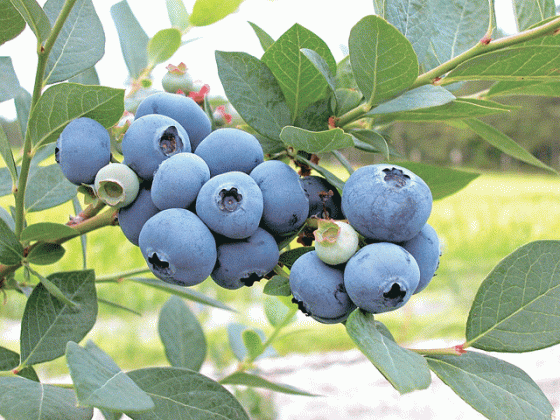
Heather Kirk-Ballard / LSU AgCenter horticulturist
Grab a bucket. The blueberries are ready to pick.
Louisianians are fortunate to live in a state that supports blueberry growth. Blueberries are easy to grow and one of the most nutritionally dense foods on Earth. They are a significant source of vitamins and secondary metabolites that are widely studied for health benefits.
Blueberry fruit is one of the richest sources of ascorbic acid and is an excellent source of antioxidants. Blueberries contain natural compounds called anthocyanins, procyanidins, chlorogenic acid and flavonoid compounds. Anthocyanin is the main antioxidant found in blueberries.
What do all these big scientific words equate to? They provide us with cancer-fighting power, help with cataracts and macular degeneration, have anti-diabetic properties and have been shown to decrease both blood pressure and cholesterol, thereby reducing the incidence of atherosclerosis and cardiovascular disease risk. Just eat them.
Hippocrates, the ancient Greek physician and “Father of Medicine” said, “Let food be thy medicine and medicine be thy food.”
Now is a great time to get your hands on some nutritious blueberries. Find local growers in your area in Louisiana at the website http://bit.ly/2HO38eh. And seriously consider growing your own at home.
Rabbiteye blueberry (Vaccinium virgatum or V. ashei) is a deciduous shrub native to the southeastern United States. It has been named a Louisiana Super Plant because of its reliability as an excellent performer in gardens and landscapes, and it also does great in containers.
Called rabbiteye because before ripening into its characteristic blue, the fruit displays a pink color resembling the eye color of an albino rabbit. Rabbiteye blueberries not only provide beneficial fruit, they are also prized for their aesthetic value for Louisiana landscapes with a delicate, blue-green foliage that turns red and orange in fall. The white umbrella-shaped flowers decorate the spring landscape before turning into fruit.
Rabbiteye blueberries make a great addition to edible landscapes.
Fruit ripens over a 4-to-6-week period, and not all ripen at the same time, so harvest can occur for several weeks. Well-maintained, mature rabbiteye blueberry bushes can be expected to yield more than 10 pounds per bush, and sometimes up to 30 pounds per bush.
Rabbiteye blueberries grow in USDA hardiness zones 8 to 10 and require acidic soils with a pH of 4.2 to 5.5. For the best fruit, a minimum of six to eight hours of full sun are required, and bushes will have the best production in full sun all day. The shrubs grow 8 feet tall and 6 feet wide and should be planted while they are dormant during fall or winter with a 4-to-6-foot spacing between plants.
Rabbiteye blueberries are shallow rooted and need well-drained soils. Optimally, blueberries should be grown in raised beds, which are a necessity in areas with heavy soils. If unsure about the soil drainage, 2 to 4 inches of aged pine bark can be blended into the soil, and the planting area should be mounded into a bed that is 6 to 10 inches high.
Rabbiteye blueberries produce best through cross pollination, and at least two to three varieties should be planted together to provide adequate pollination.
Ensure proper moisture, especially during drought periods or in sandy soils. Apply 3 to 4 inches of mulch around bushes. Rabbiteye blueberries are susceptible to over-fertilization, especially young plants. Fertilizer should be divided into multiple applications each year and applied at low rates.
Once in early spring at flowering and again in the summer after harvest. Yellowing of younger leaves is common and is caused by a decreased uptake of iron when soil pH is high. Use an acidifying, complete fertilizer for acid-loving plants, such as azaleas. These types of fertilizers are readily available in garden centers and hardware stores. No major pests have been noted.
Heavy pruning is not necessary; however, some pruning may be desirable to keep the fruit within easy reach and to encourage new growth. To reduce the height of a bush, trim shortly after harvest to allow time for new growth to set fruit buds for the following year. Prune dead branches in late winter to early spring, and thin lower limbs to keep fruit off the ground. On older plants, it is acceptable to cut out approximately one-fifth of the oldest canes (trunks) each year.
Choose a variety that has a chilling requirement compatible with your location. The southernmost areas of Louisiana may not get enough chill hours for consistent fruit production in all varieties. Traditional varieties like Premier, Climax, Brightwell, Tifblue and Powderblue remain well-suited to most areas of Louisiana. More recently released varieties like Alapaha, Ira, Onslow, Ochlockonee and DeSoto are likely to perform well but have not been formally evaluated in Louisiana. (These varieties are listed in approximate order of ripening.) The Prince variety has one of the lowest chill hour requirements and produces fruit early in the season, so it’s a good choice for south Louisiana locations.
